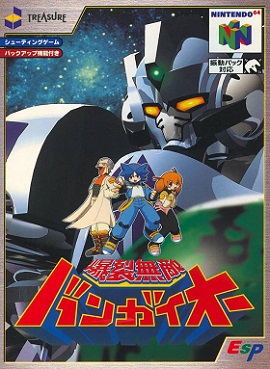
Bangai-O is a multidirectional shooter developed by Treasure and released in 1999 on the Nintendo 64 in Japan. It was ported to the Dreamcast worldwide shortly after with some gameplay changes and updated graphics and audio. The game places the player in control of a weaponized mech that can hover across large stages and fire at enemies all around them. The player must reach the end of each stage and defeat the boss, while avoiding hazards scattered across the map such as enemy mechs and gun turrets.
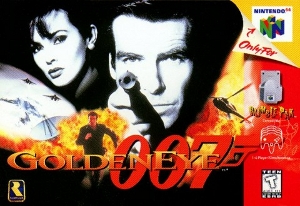
GoldenEye 007 is a 1997 first-person shooter video game developed by Rare and published by Nintendo for the Nintendo 64. Based on the 1995 James Bond film GoldenEye, the player controls the secret agent James Bond to prevent a criminal syndicate from using a satellite weapon. They navigate a series of levels to complete objectives, such as recovering or destroying objects, while shooting enemies. In a multiplayer mode, up to four players compete in several deathmatch scenarios via split-screen.
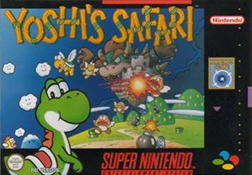
Yoshi's Safari is a 1993 light gun shooter developed and published by Nintendo for its Super Nintendo Entertainment System (SNES). It is the only Mario franchise game to feature first-person shooter gameplay and requires the SNES's Super Scope light gun. As Mario and his pet dinosaur Yoshi, the player embarks on a quest to save the kingdom of Jewelry Land from Bowser and his Koopalings, who have kidnapped its rulers and stolen 12 gems. The game features 12 levels in which the player shoots enemies like Goombas and Koopas, and collects power-ups and coins. At the end of each level, the player engages in a boss fight with an enemy, a Koopaling, or Bowser. Nintendo commissioned its R&D1 department to develop Yoshi's Safari in response to the waning popularity of the Super Scope. Yoshi's Safari was the first Super Scope title to use the SNES's Mode 7 graphics mode, and the future of the peripheral depended on the game's performance.
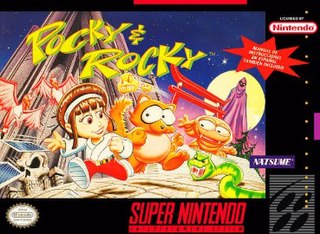
Pocky & Rocky is a 1992 scrolling shooter video game developed and published by Natsume for the Super Nintendo Entertainment System. It is the sequel to Taito's 1986 arcade game KiKi KaiKai. Pocky & Rocky follows the adventures of a young Shinto shrine maiden, Pocky, and her new tanuki companion, Rocky, as they attempt to save a group of goblins from evil forces. Gameplay takes place from a top-down perspective and features both single-player and cooperative modes.

Sunset Riders is a side-scrolling run and gun video game developed and released by Konami as an arcade video game in 1991. It is set in the American Old West, where the player(s) take control of bounty hunters who are seeking the rewards offered for various criminals.

Kirby Super Star, released as Kirby's Fun Pak in PAL regions, is an anthology platform video game developed by HAL Laboratory and published by Nintendo for the Super Nintendo Entertainment System in 1996. It is part of the Kirby series of video games by HAL Laboratory. The game was advertised as a compilation featuring eight games: seven short subsections with the same basic gameplay, and two minigames.

Stunt Race FX, known in Japan as Wild Trax, is a racing video game developed by Nintendo and Argonaut Software and published by Nintendo for the Super Nintendo Entertainment System. It is the second game to use the 3D-centric Super FX powered GSU-1.

Battle Clash is a 1992 light gun shooter video game developed by Intelligent Systems and published by Nintendo for the Super Nintendo Entertainment System. It is one of several titles that requires the Super Scope light gun. The plot takes place in a futuristic post-apocalyptic Earth, where battles are fought with mechs called Standing Tanks (STs) and the winner takes control of the world. A young man named Mike Anderson participates in the Battle Game to face the ruthless champion Anubis and avenge his father's death. The player acts as the gunner of the ST Falcon piloted by Anderson, taking on Anubis and his subordinate chiefs in one-on-one fights.

Axelay is a 1992 scrolling shooter video game developed and published by Konami for the Super Nintendo Entertainment System. Set in the fictional solar system Illis where an alien empire known as "Armada of Annihilation" invades its planets including the Earth-like Corliss (Mother), players take control of the titular D117B space fighter craft as a last resort to stop the alien invasion by recovering its lost weaponry. The gameplay mainly consist of both vertical-scrolling and horizonal-scrolling stages in the same vein as Konami's own Life Force, with players choosing three different weapon-types that increase in number as they progress through the game.
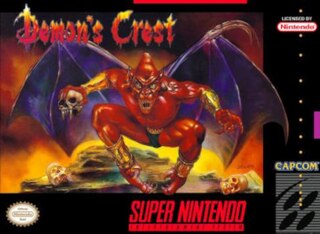
Demon's Crest, known in Japan as Demon's Blazon, is a side-scrolling platform video game developed and published by Capcom for the Super Nintendo Entertainment System. It is the third video game starring Firebrand, following Gargoyle's Quest and Gargoyle's Quest II.

Tin Star is a shoot 'em up video game developed by Software Creations and released by Nintendo for the Super Nintendo Entertainment System (SNES) in North America in November 1994. Starring anthropomorphic robot characters, it follows a seven-day adventure of the titular sheriff who fights the criminal Bad Oil Gang from taking over the town of East Driftwood.
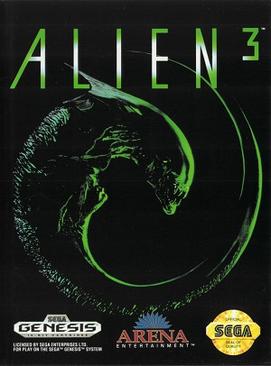
Alien 3 is a run and gun game based on the 1992 film of the same name. It was released for the Genesis and Amiga in 1992, then for the Commodore 64, Game Boy, Game Gear, Nintendo Entertainment System, Super Nintendo Entertainment System, and Master System.

Blood Bros. is a 1990 arcade game developed and published by TAD Corporation in Japan and Europe, and later published in North America by Fabtek. It is a spiritual sequel to the 1988 game Cabal, with almost identical mechanics. A bootleg of Blood Bros. is known as West Story.

Waterworld is a series of video games released for the Super Nintendo Entertainment System, Virtual Boy, MS-DOS, Microsoft Windows and Game Boy, based on the film of the same name, along with unpublished versions for the Mega Drive/Genesis, Sega Saturn, Atari Jaguar, 3DO and PlayStation. These games were produced by Ocean Software. The SNES and Game Boy games were released only in Europe in 1995 and the Virtual Boy game was released exclusively in North America in November 1995. It was released for PC in 1997. The game received widespread negative reviews and the version released for the Virtual Boy is generally considered to be the worst game of its 22 releases.

BlaZeon is a horizontally scrolling shoot 'em up arcade game released by Atlus in 1992 and was ported to the Super Nintendo Entertainment System in the same year. The game's most distinguishable feature is that players come equipped with a device that allows them to freeze and control certain robots.

Jurassic Park 2: The Chaos Continues is a 1994 video game and a non-canonical continuation of the Jurassic Park series, developed and published by Ocean Software for the Super Nintendo Entertainment System (SNES). It is a sequel to the SNES game Jurassic Park.

Contra III: The Alien Wars is a 1992 run and gun video game developed and published by Konami for the Super Nintendo Entertainment System (SNES). It is the third home console entry in the Contra series after Contra (1988) and Super C (1990) for the Nintendo Entertainment System (NES). In PAL regions, it was retitled Super Probotector: Alien Rebels and the player characters were replaced with robots. The player is tasked with fighting off an alien invasion of Earth across six stages. Four stages feature side-scrolling action traditional to the series while two are presented from an overhead perspective. It is the first Contra title to have been directed by Nobuya Nakazato who later directed other games in the series. He designed Contra III to feature more comical elements, a more cinematic soundtrack, and tighter stage design than its predecessors.

The Ninja Warriors is a beat 'em up video game developed by Natsume for the Super Nintendo Entertainment System and published by Taito in Japan and North America in 1994 and by Titus in Europe in 1995. It is a follow-up to Taito's 1987 arcade game of the same title, and shares similar gameplay. The player can choose between playing as one of three ninja androids, each with different attributes and a unique set of moves including jumps, dashes, throws, and other attacks. The game was developed by the same team at Natsume that later developed Wild Guns (1994).
Enter the Gungeon is a 2016 bullet hell roguelike game developed by Dodge Roll and published by Devolver Digital. Set in the firearms-themed Gungeon, gameplay follows four player characters called Gungeoneers as they traverse procedurally generated rooms to find a gun that can "kill the past". The Gungeoneers fight against bullet-shaped enemies, which are fought using both conventional and exotic weapons. Enter the Gungeon features a permadeath system, causing the Gungeoneers to lose all obtained items and start again from the first level upon death. Between playthroughs, players can travel to an area called the Breach, where they can converse with non-player characters and unlock new items randomly encountered while playing.

Shin Kidō Senki Gundam Wing: Endless Duel is a 1996 fighting video game developed by Natsume Co., Ltd. and published in Japan by Bandai for the Super Famicom. It is the first game to be based on the Mobile Suit Gundam Wing anime series. Set in the year After Colony 195, players take control of a pilot from the Colony Liberation Organization or the Organization of the Zodiac. Its gameplay consists of one-on-one fights, with a main four-button configuration, featuring special moves, as well as three playable modes.





















